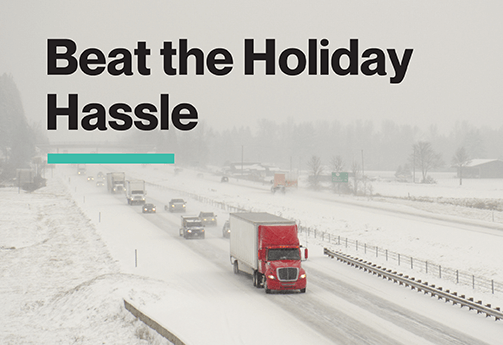Beat the holiday hassle with HDVI

While the holidays can be a wonderful time of year for you and your family, it can also be a stressful time for the transportation industry. Increased holiday consumer demand and a spike in holiday traffic can lead your team to experience long delays on the road, extended waits when loading and unloading, impatient vendors wanting to know where their freight is, drivers running out of hours and more.
All this seasonal stress can really put a strain on your company’s safety program. So, what can you do to prevent or alleviate some of the stress?
Plan ahead with these seasonal trucking tips
- Talk with your drivers about tight deliveries and possible delays. Work with them to plan ahead and map out breaks and bail-out location options if delays become too long.
- Give your drivers clear direction on what to do in case they run out of hours or are involved in an accident. Who do they call – Safety, Dispatch, the Owner? They must also remember to stay on duty while on the roadway at a crash before they move to the nearest safe haven.
- Set company expectations. What is expected if a driver gets lost? Many will just take random roads hoping to find a way out. Have your drivers check maps or Google, pull over and investigate the correct route, or reach out to law enforcement if necessary.
- Eliminate uncertainties for the driver. By doing this, you can keep your driver calm and reduce the chance that they will make a panicked decision which usually leads to an accident.
- Make the driver the captain of their ship. Many shippers will try to force a driver into an unsafe situation like a tight dock or space on the yard. Just because a yard truck can fit doesn’t mean that a conventional truck will. Allow your driver to make the right decision for your company. If they don’t feel that they can safely make a maneuver, be their advocate and support them.
Understanding the adverse driving exemption
Another great tip: Ensure your drivers understand the adverse driving exemption. The FMCSA defines adverse conditions as: “snow, sleet, fog, or other weather conditions like a highway covered with snow or ice or unusual road and traffic conditions—none of which were apparent on the basis of information known to the person dispatching the run at the time it was begun.”
If any of the conditions described above exist, drivers may continue driving until the intended destination is reached or until they are able to safely reach a secure location—but for no more than two extra hours. It is important that drivers notate their log when using the exemption. They must also provide as much detail as possible.
Using personal conveyance
Being clear with your driver about how and when to use personal conveyance is another way to be as prepared as possible this holiday season. For instance, personal conveyance should not be used if the driver runs out of hours while on the roadway. It should also not be used to drive home from a shipper or vendor. Here’s when driver should elect to use personal conveyance:
- From temporary lodging to a restaurant: Time spent traveling from a driver’s place of lodging during a trip, such as a motel or truck stop, to restaurants or entertainment facilities is personal conveyance.
- Between home and work: A driver’s journey back and forth between their home terminal and their residence, between trailer-drop lots and their residence, and between work sites and their residence all count as personal conveyance, with the following caveat: The commuting distance and time must be short enough to allow the driver to get enough sleep to return to work in an unfatigued state.
- Travel to a nearby safe location to rest after loading or unloading: Finding a safe place to park and rest is the most crucial element of personal conveyance for drivers on the road. The chosen rest location must be close enough to allow the driver time to get enough sleep before returning to work. The rest location also needs to be the nearest one that’s reasonably available, even if that means the trucker will have to drive farther when they are back on duty.
- Repositioning of a CMV at the request of a safety official during the driver’s off-duty time: If a driver is required to move a vehicle while off duty, this counts as personal conveyance.
- Time spent traveling in a motorcoach without passengers to en route lodging or to restaurants and entertainment facilities and back to the lodging: The driver, provided they are off duty, can claim personal conveyance for time spent traveling without passengers to a motel or truck stop, for example, as well as from their lodging location to a restaurant. Other off-duty drivers may be on board the vehicle; they are not considered passengers.
- Time spent transporting personal property while off duty: If, for example, an off-duty driver takes their CMV to a used auto parts shop and picks up a part for a car they are restoring at home as a hobby, this is considered personal conveyance.
- Authorized use of a CMV to travel home after working at an off-site location: This particular scenario is intended for construction and utility companies that set up base camps near a major job and operate from there for days or weeks at a time. These remote locations are considered off-site locations. Travel between home and that off-site location qualifies as personal conveyance.
With just a little planning ahead and help from HDVI, everyone on your team can have a happy holiday.


